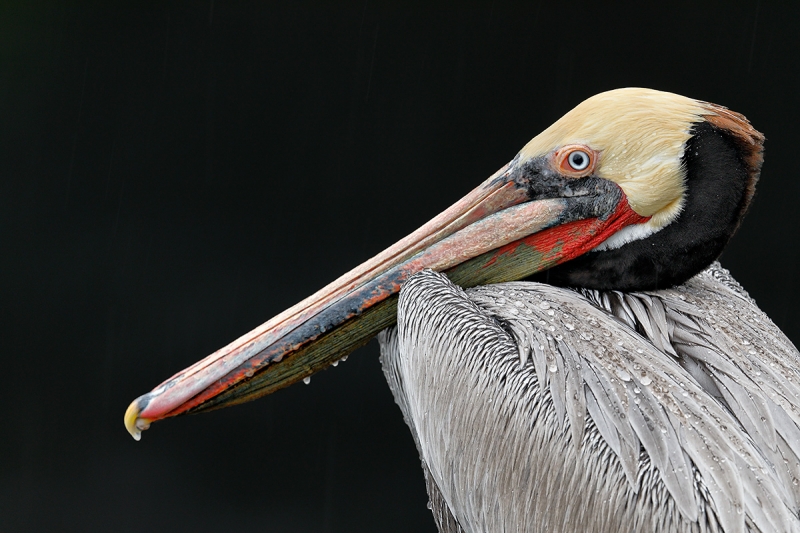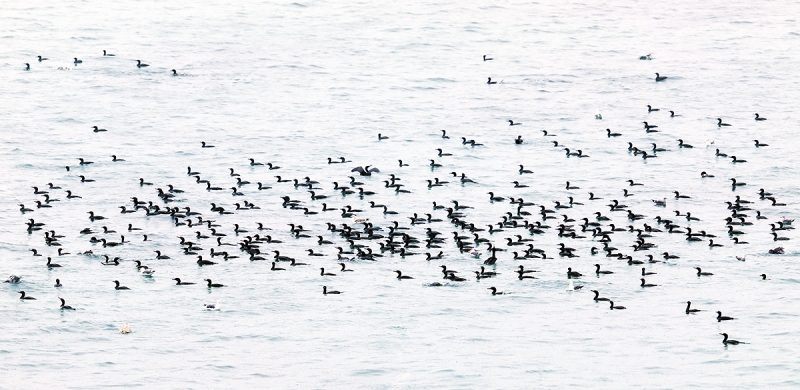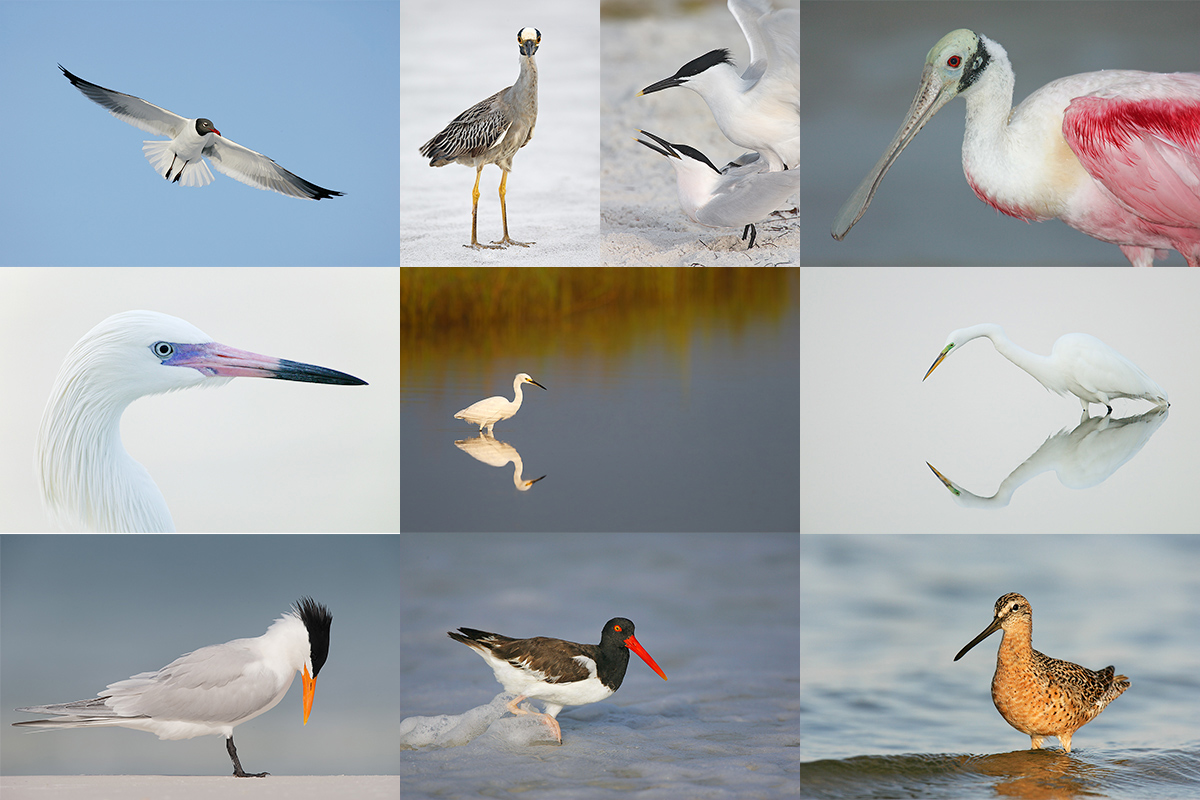What’s Up?
Patrick Sparkman and I enjoyed another wonderful morning with the pelicans and then moved down the coast a bit to do more gulls in flight. We returned to the Whimbrel site only to find no Whimbrels. But we did have some great chances with California Gulls of various ages, several Willets, and some very colorful and cooperative rock formations. Image coming soon.
Gear Questions and Advice
Too many folks attending BAA IPTs and dozens of folks whom I see in the field, and on BPN, are–out of ignorance–using the wrong gear, especially when it comes to tripods and more especially, tripod heads… Please know that I am always glad to answer your gear questions via e-mail.
The Streak: 431!
Today’s blog post marks a totally insane, irrational, illogical, preposterous, absurd, completely ridiculous, unfathomable, silly, incomprehensible, what’s wrong with this guy?, makes-no-sense, 431 days in a row with a new educational blog post. As always–and folks have been doing a really great job recently–please remember to use our B&H links for your major gear purchases. For best results use one of our many product-specific links; after clicking on one of those you can continue shopping with all subsequent purchases invisibly tracked to BAA. Your doing so is always greatly appreciated. Please remember: web orders only. And please remember also that if you are shopping for items that we carry in the BAA Online Store (as noted in red at the close of this post below) we would of course appreciate your business.
|
This image was created at La Jolla, CA with the Induro GIT 304L/Mongoose M3.6-mounted Canon EF 500mm f/4L IS II USM lens, the Canon Extender EF 1.4X III, and my favorite bird photography camera, the Canon EOS 5D Mark IV. ISO 1000. Evaluative metering -1 stop: 1/80 sec. at f/5.6 in Manual mode. Cloudy WB. Center AF point/AI Servo Expand/Rear Focus AF as framed was active at the moment of exposure. The selected AF point just caught the lower right part of the bird’s eye. Click on the image to see a larger version. FocusTune/LensAlign Micro Adjustment: -1. Brown Pelican in rain with black BKGR
|
Photographing Birds at La Jolla in the Rain: Part III
At my rainy/windy day pelican spot, it is easy to line the birds up with very dark even black backgrounds. Be sure to underexpose to keep from toasting the highlights; as always, after making a test image make, sure that you have some data in the rightmost box of the histogram while avoiding any blinkies on the subject.
FocusTune/LensAlign Micro Adjustment Note
Eagle-eyed readers might have noted that with previous images made with the 500 II/1.4X III/5D IV combination that the micro-adjustment was +2. With today’s image, it was -1. As the lens and the camera body were the same in each case and I have not redone the LensAlign/FocusTuning, what is the only possible explanation?
|
This image was created at La Jolla, CA with the Induro GIT 304L/Mongoose M3.6-mounted Canon EF 500mm f/4L IS II USM lens and my favorite bird photography camera, the Canon EOS 5D Mark IV. ISO 800. Evaluative metering +2 stops: 1/60 sec. at f/4 in TV mode. Cloudy WB. Three AF points to the right and two rows up from the center AF point/AI Servo Expand/Rear Focus AF as framed was active at the moment of exposure (as is always best when hand holding). The selected AF point was just in front of and just below the bird’s eye. Click here to see the latest version of the Rear Focus Tutorial. Click on the image to see a larger version. Cormorant feeding spree |
ID and Image Settings Quiz Answers
In the Photographing Birds at La Jolla in the Rain: Part II blog post here, I posted with regards to the image above:
ID Quiz
Where in the frame are the three Heerman’s Gulls? Where in the frame is the probable 1st winter Glaucous-winged Gull?
Krishna Prasad Kotti was the first to reply with the correct answers: All three Heerman’s Gulls are on the right side of the frame, one to the edge of the frame, one right side bottom, and another left of the first one.
The 1st winter Glaucous-winged Gull is on the left side bottom.
Note: there are a few adult Western Gulls scattered about along with a first winter pretty much dead center.
Well done Krishna.
Image Settings Quiz
1-Why TV mode?
TV mode allows for absolute control of shutter speed.
2-Why 1/60 sec.?
I know that I could make a sharp image at 1/60. sec.
3-Why +2 EC?
When the scene averages to much lighter than a middle tone the meter is stupid.
4-How’s the histogram?
The histogram is perfect.
Please Remember to use my Affiliate Links and to Visit the New BAA Online Store 🙂
To show your appreciation for my continuing efforts here, we ask, as always, that you get in the habit of using my B&H affiliate links on the right side of the blog for all of your photo and electronics purchases. Please check the availability of all photographic accessories in the New BIRDS AS ART Online Store, especially the Mongoose M3.6 tripod head, Wimberley lens plates, Delkin flash cards and accessories, and LensCoat stuff.
As always, we sell only what I have used, have tested, and can depend on. We will not sell you junk. We know what you need to make creating great images easy and fun. And please remember that I am always glad to answer your gear questions via e-mail.
I would of course appreciate your using our B&H affiliate links for all of your major gear, video, and electronic purchases. For the photographic stuff mentioned in the paragraph above, and for everything else in the new store, we, meaning BAA, would of course greatly appreciate your business. Here is a huge thank you to the many who have been using our links on a regular basis and those who will be visiting the New BIRDS AS ART Online Store as well.
|
DeSoto in spring is rife with tame and attractive birds. From upper left clockwise to center: breeding plumage Dunlin, dark morph breeding plumage Reddish Egret displaying, breeding plumage Laughing Gull/front end vertical portrait, breeding plumage Laughing Gull with prey item, Laughing Gull on head of Brown Pelican, screaming Royal Tern in breeding plumage, Royal Terns/pre-copulatory stand, Laughing Gulls copulating, breeding plumage Laughing Gull/tight horizontal portrait, Sandwich Tern with fish, and a really rare one, White-rumped Sandpiper in breeding plumage, photographed at DeSoto in early May. |
Fort DeSoto Spring IPT/April 19-22, 2017. (meet & greet at 2pm on Wednesday April 19 followed by an afternoon session) through the full day on Saturday April 22. 3 1/2 DAYs: $1599. Limit 10. To save your spot, please call and put down a non-refundable deposit of $499.00.
I will be offering small group (Limit 3) Photoshop sessions on Sunday afternoon and Monday morning if necessary. Details on that TBA.
Fort DeSoto is one of the rare locations that might offer great bird photography 365 days a year. It shines in spring. There will Lots of tame birds including breeding plumage Laughing Gull and Royal and Sandwich Terns. With luck, we will get to photograph all of these species courting and copulating. There will be American Oystercatcher and Marbled Godwit plus sandpipers and plovers, some in full breeding plumage. Black-bellied Plover and Red Knot in stunning breeding plumage are possible. There will be lots of wading birds including Great and Snowy Egrets, both color morphs of Reddish Egret, Great Blue, Tricolored and Little Blue Heron, Yellow-crowned Night-Heron, and killer breeding plumage White Ibis. Roseate Spoonbill and Wood Stork are possible and likely. We should have lots of good flight photography with the gulls and terns and with Brown Pelican. Nesting Least Tern and nesting Wilson’s Plover are possible.
We will, weather permitting, enjoy 7 shooting sessions. As above, our first afternoon session will follow the meet and greet at 2pm on Wednesday April 19. For the next three days we will have two daily photo sessions. We will be on the beach early and usually be at lunch (included) by 11am. We will have three indoor sessions. At one we will review my images–folks learn a ton watching me choose my keepers and deletes–why keep this one and delete that one? The second will be a review of your images so that I can quickly learn where you need help. For those who bring their laptops to lunch I’d be glad to take a peek at an image or three. Day three will be a Photoshop session during which we will review my complete workflow and process an image or two in Photoshop after converting them in DPP. Afternoon sessions will generally run from 4:30pm till sunset. We photograph until sunset on the last day, Saturday, April 22. Please note that this is a get-your-feet and get-your-butt wet and sandy IPT. And that you can actually do the whole IPT with a 300 f/2.8L IS, a 400 f/4 ID DO lens with both TCs, or the equivalent Nikon gear. I will surely be using my 500 II as my big glass and have my 100-400 II on my shoulder.
|
DeSoto in spring is rife with tame and attractive birds. From upper left clockwise to center: Laughing Gull in flight, adult Yellow-crowned Night-Heron, copulating Sandwich Terns, Roseate Spoonbill, Great Egret with reflection, Short-billed Dowitcher in breeding plumage, American Oystercatcher, breeding plumage Royal Tern, white morph Reddish Egret, and Snowy Egret marsh habitat shot. |
What You Will Learn
You will learn to approach free and wild birds without disturbing them, to understand and predict bird behavior, to identify many species of shorebirds, to spot the good situations, to understand the effects of sky and wind conditions on bird photography, to choose the best perspective, to see and understand the light, to get the right exposure every time after making a single test exposure, and to design pleasing images by mastering your camera’s AF system. And you will learn how and why to work in Manual mode (even if you are scared of it).
The group will be staying at the Red Roof Inn, St. Petersburg: 4999 34th St. North, St Petersburg, FL 33714. The place is clean and quite inexpensive. Please e-mail for room block information. And please call Jim or Jennifer at 863-692-0906 to register. All will need to purchase an Annual Pass early on Tuesday afternoon so that we can enter the park at 6am and be in position for sunrise opportunities. The cost is $75, Seniors $55. Tight carpools will be needed and will reduce the per person Annual Pass costs. The cost of three lunches is included. Breakfasts are grab what you can on the go, and dinners are also on your own due to the fact that we will usually be getting back to the hotel at about 9pm. Non-photographer spouses, friends, or companions are welcome for $100/day, $350 for the whole IPT.
BIRDS AS ART Fort DeSoto In-the-Field Meet-up Workshop (ITFW): $99
Fort DeSoto Spring In-the-Field Cheap Meet-up Workshop (ITFW) on the morning of April 22, 2017: $99
Join me on the morning of April 22, 2017 for 3-hours of photographic instruction at Fort DeSoto Park. Beginners are welcome. Lenses of 300mm or longer are recommended but even those with 70-200s should get to make some nice images. Teleconverters are always a plus.
You will learn the basics of digital exposure and image design, autofocus basics, and how to get close to free and wild birds. We should get to photograph a variety of wading birds, shorebirds, terns, and gulls. This inexpensive morning workshop is designed to give folks a taste of the level and the quality of instruction that is provided on BIRDS AS ART Instructional Photo-tours. I hope to meet you there.
To register please call Jim or Jennifer during weekday business hours with a credit card in hand to pay the nominal registration fee. Your registration fee is non-refundable. You will receive a short e-mail with instructions, gear advice, and meeting place one week before the event.
Be sure to like and follow BAA on Facebook by clicking on the logo link upper right. Tanks a stack.
Typos
In all blog posts and Bulletins, feel free to e-mail or to leave a comment regarding any typos or errors. Just be right :).


















With that Canon body, 2 micro-focus adj. settings allowed for zoom lens — one for each extreme.
Is this a reading test? I think it has to be a different camera body, still a 5D IV but a different copy. If MFA is the same as it used to be the camera remembers MFA settings based on the lens model. A lens and TC combination is a different than the lens alone.
Since it is the camera body that knows and sets the adjustment the only way for it to change, without it being reset, is to have a different body. On any given body, with a 500/1.4x MFA, any 500mm & 1.4TC combination would get the same adjustment.
Nope 🙂 And not a reading test. See below.
a
Dramatic!
Andy, Ryan, and Frank. Could be … Frank, get her well fast! Am sending love, strength, and energy.
artie
ps: Guido too.
I’m with Ryan and Andy: different 1.4x
I presume that you chose 1/60 sec to avoid having water drops movement affecting the view of the bird. Am I right? By using a higher shutter speed you would have immobilized water drops in the foreground and background around the bird. This can only be done with a sturdy tripod and good technique at that focal length.
Hi Pierre, Not right. See below.
Thanks of course for commenting; it is a great way to learn.
artie
Hi Artie,
Only explaination on the change in focus tune adjustment is you used a different 1.4 converter. I know you carry two and each one needs to be tuned. Laurie’s surgury was yesterday. All went well.
Frank
Different 1.4X TC III
In response to the question of different micro adjustment values, did you use a different 1.4XIII converter than previously?
Lens align/Focus – Since you typically carry a couple of TC’s, I assume you have aligned the same body and 500mm with each TC and have different optimal settings for each combo.
“As the lens and the camera body were the same in each case and I have not redone the LensAlign/FocusTuning, what is the only possible explanation?”
Because in “real life” shooting you were getting more OOF shots than normal with +2. I’m probably wrong, so I’ll be interested to see why.
Yup to wrong 🙂 Thanks though for commenting.
artie
Re the micro focus adjustment, I believe the difference is because you have more than one 1.4 iii, one requires-1 adjustment while the other a +2
I’m a bit puzzled on the question of shutter speed.
“2-Why 1/60 sec.?
I know that I could make a sharp image at 1/60. sec.”
Saying ‘because I could’ does not really explain why you chose it. With cloudy conditions my thinking is that the 1/60 was driven by your selected aperture and ISO, in which case I would ask why did you not increase ISO to 1600 and get a quicker shutter speed, given the birds would be moving (whether swimming or bobbing on the water)
You are correct but so am I 🙂 In most situations I am reluctant to go much below 1/60 sec. with a telephoto lens. So that is pretty much my minimum. Setting 1/60 with the proper EC does give me the lowest possible ISO for the situation. Note that distant (swimming or feeding) birds will rendered much sharper than closer (swimming or feeding) birds thus no need in this situation to go to a higher ISO for more shutter speed … That’s why 🙂
IAC, we are in part on the same page.
a